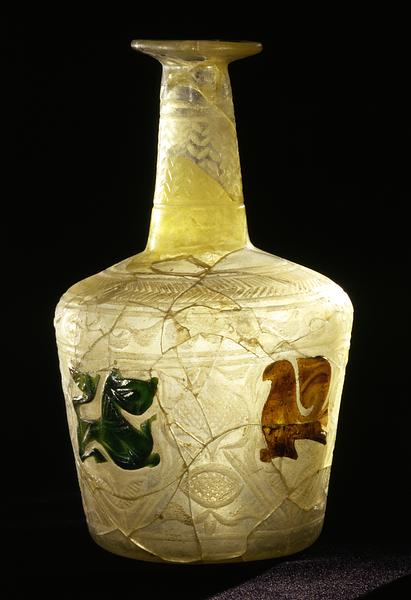Bottle, colorless glass, with relief-cut decoration and a green and brown overlay
Iraq or Iran; 9th-10th century
H: 23 cm
Instead of using the overlay technique, in which the craftsman cut into a glass body with two-colored layers (see
3/1971), he could apply sections of colored glass to the colorless glass and then cut them into the desired shape.
Glass objects made with this simpler technique often have a coarser finish than those made with the overlay technique, and the two layers are sharply defined because the glass was cut vertically and not diagonally.
The animals in brown and green glass on this bottle are coarser versions of motifs that first appeared on glass excavated in Abbasid Samarra. The colorless glass has a simple leaf and line ornamentation.
Inv. no. 2/1972
Published in:
Journal of Glass Studies, 15, 1973, fig. 17, pp. 190-191;
André Leth: Davids Samling. Islamisk kunst = The David Collection. Islamic Art, København 1975, pp. 19-20;
The arts of Islam : Hayward gallery, 8 April - 4 July 1976, London 1976, cat.no. 128;
Kjeld von Folsach: Islamic art. The David Collection, Copenhagen 1990, cat.no. 219;
Stefano Carboni and David Whitehouse: Glass of the Sultans, Corning Museum of Glass, New York 2001, cat.no. 100;
Kjeld von Folsach: Art from the World of Islam in The David Collection, Copenhagen 2001, cat.no. 307;
Jacqueline du Pasquier: Histoire du verre: les chefs-d'oeuvre de l'islam, Paris 2007, p. 90;
Yōko Shindō: Isurāmu garasu = Islamic glass, ed. Tomoko Masuya, Nagoya 2020, fig. 29;
